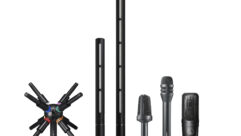
Audio for New NY Night Club, Part 1
Oct 9, 2012 11:54 AM
With Bennett Liles
menu> Listen to the Podcasts
Part 1 | Part 2
Editor’s note: For your convenience, this transcription of the podcast includes timestamps. If you are listening to the podcast and reading its accompanying transcription, you can use the timestamps to jump to any part of the audio podcast by simply dragging the slider on the podcast to the time indicated in the transcription.

54 Below nightclub is an intimate club installed with Meyer Sound UPJ-1P self-powered speakers to fill the space without blowing out the volume.
When Broadway play producers got together and decided they wanted a new club, the place to be and to be seen right after the biggest shows, they called in Masque Sound to set up an audio system perfect for the New York club, 54 Below. Matthew Peskie is ready to tell us all about how Masque Sound did the job, next up on the SVC Podcast.
SVC: OK, Matt. I wanted to get into what sounds like a very wild and crazy place with the New York club 54 Below right in the middle of the big Broadway show district. But first tell me something about your outfit, Masque Sound.
Matthew Peskie: Well, Masque has been around for about 75 years. We just celebrated our 75th anniversary last year. Founded by Geoff Shearing’s grandfather, who currently runs the company, so it’s a third-generation company that’s primarily involved with Broadway shows and Broadway show tours for the most part, but has delved into the install division, install side of things, starting about 5-6 years so now. We have a good strong install division going along, and it kind coincides with the Broadway stuff and lends us to do a fair amount of installs on the Broadway side in a lot of theaters and is kind of how the 54 Below project kind of came around to us as well. [Timestamp: 1:39]
And I think you could run into some pretty unusual sound requirements for some of the shows they do. I think everybody is familiar with the famous club Studio 54, and I think this club is right below where that one was.
It is directly below it, correct. [Timestamp: 1:52]
OK and what sort of a venue is that? What do they do there?
It is very similar to kind of a Cabaret-style dinner theater kind of environment, where it’s a very intimate environment where people are sitting around the stage, at least up to 180 degrees around the stage, and then you hit the back wall. But it’s just a very intimate environment to see whether it’s a comedian or whether it’s a jazz ensemble or a singer/song writer or whatever it might be. It’s just a very small intimate atmosphere that they tried to bring back to kind of the Broadway scene to get people before and after Broadway shows, give them a place to kind of getting into the spirit, kind of feel that spirit of the Cabaret atmosphere. [Timestamp: 2:36]
Right, make it the place to be right after the show, I guess.
Exactly, exactly.

Construction during the build-out of the NY club 54 Below
Was this all new construction where you got in fresh or was it an upgrade retrofit where you took out an existing system?
No, this was new construction. It was just an existing basement was all it was, so it was new construction from a generic existing basement. The whole thing was put into play by some big guys on the Broadway side. They kind of got everybody involved from the sound designer to the set to the lighting was all done by people that have won Tonys and won awards for Broadway work that they’ve done. So I think they kind of wanted, that was the heart and soul of it was that this was a place that these people wanted to see that they wanted to have happen. So it was new construction, and it was really a pretty tight schedule, a pretty ambitious schedule in regards to when we came in, which was kind of late in the game. They had already broken ground for lack of better term and gotten the ball rolling on construction, so by the time we got in, it was pretty much contracted and away we go—get right into it real quick so. [Timestamp: 3:44]
OK, so you had your work cut out for you. Now who did the basic design on this? The original layout for all this?
Peter Hylenski did the design for it and he worked with the Walters-Storyk Design Group, who had a lot to do with the acoustics of the room, the acoustic modeling, and a lot of material that was used in the space because there are businesses located above 54 Below, and you also have the club up above where they do performances. So all sound isolation that was a big factor and when it was all said and done there could be a show going on downstairs and you would have no idea that it was happening, so it’s very, very isolated downstairs. [Timestamp: 4:21]
Audio for New NY Night Club, Part 1
Oct 9, 2012 11:54 AM
With Bennett Liles
Yeah, that would be the big thing. You sure don’t want a lot of people listening to bass booming through the walls next door.
Oh yeah, and you could tell as the room was being built and they were starting to apply the soft goods and starting to get the isolating materials up, you could just sense that it was getting quieter and that it was getting dead inside the space. So the end result is it’s really nice looking and the ornamentation and all of the trim and woodwork and all those things really stand out. It’s just a really, really nice looking room. [Timestamp: 4:52]
And I would think that part of the sound isolation would be your ability to keep volume levels at a minimum. Did you set out to distribute the sound as much as possible by wire and use a lot of speakers so that each one has a minimum area to cover?
Yeah, I think it’s kind of two-fold. I think the performances that they have there kind of lend themselves to helping out in that respect that they’re not going to be at high volume in the first place, so the room was basically the speakers and the amount of speakers are really laid out for coverage. So no matter where you are in the performance space area you pretty much are right in the throw of the speaker, which really helps so you don’t have to crank up the volume in order to be right in the coverage of the speaker. So there’s the main Meyer system that covers the main room itself and then there’s, I think, it’s there’s about 8-10 zones of Tannoy ceiling speakers that cover the bar area, that cover the entry way, the dressing rooms, the kitchen, the restrooms—all those other places all have individually zoned and zone controlled ceiling speakers. [Timestamp: 5:57]
And you were talking about the timeframe on this. So when you first got in there what did you have to do and how fast did you have to get rolling on everything?
Well, it was pretty fast just in regards to what we had to get done, what we had to get located in the ceiling before they started closing the ceiling, so making sure that our conduit sizes were correct, that our amounts of wire going into said conduits, that the conduit was sized correctly and locations were marked out to get our anchors, our Unistrut and threaded rods set in place in order to give us a place to hang our main array speakers from. So it’s just things of that nature. All those typical things that have to happen before sheet rock goes up and then you no longer have access to those spaces. [Timestamp: 6:37]
I found that interesting what you said about how it got quieter in there as the construction went on. So how did the acoustics work out as the finished product? Obviously, they got the place carpeted…
Yeah.
…they’ve got isolation in the walls, so it appears that that part of it was given a lot of attention and it worked out.
Yeah, it really came out nice. I know when Peter Hylenski came in and did the final tuning of the room, I know he spent a lot of time just in regards to time alignment and coverage and getting all that stuff correct, but I don’t recall there being any major issues in regards to like a standing wave or any kind of frequencies that were just jumping out at you. So ultimately it ended up sounding—it came out sounding really, really nice. [Timestamp: 7:16]
What kind of Meyer speakers did you use in there? We’re they the self-powered ones?
Yeah, we used all self-powered. There are four UPJ-1Ps that are the main four speakers in the array, but then there’s also a half dozen of the UP-4XPs, which use the rack-mounted power supply. So there are six of those that are kind of filling in in the front rows and off on the sides to give all that coverage that we talked about and then there are four 500-HPs under the stage, which you might think is overkill but no, these things are not being driven at 10. You know they’re not being driven hard, so again they’re really there for the coverage more than anything else. [Timestamp: 7:55]
So they don’t have to put in the ear plugs and blast everything up to 11 or anything.
Yeah, exactly, not only do you have acts coming in that don’t play at the high volume, but with just the shear coverage of speakers, because sometimes you might push the volume on something really just to try to cover it to the far back of the room or try to, you know, hit the sides a little bit more, but with just the total amount of speakers that are there, the coverage is really built in from the get go. [Timestamp: 8:23]
And no problems with getting clean power run to the speakers.
No, and thankfully that was the good thing about having it being new construction is that we could say right here is where we need a circuit, right here is where we need a circuit. So yeah, so that was nice and easy just spending a lot of time working with the onsite electrician making sure that he has the current set of our prints. He knows where he needs to put things and then obviously we always walk everybody through every detail just to make sure that it’s said once so they have an understanding of, “Yeah, this is where this needs to go.” [Timestamp: 8:54]
Well, it sounds like it was probably fun to work on in having it all come out like it did. Matt Peskie from Masque Sound. It was good having you here and in part two, the mixing console and the Millennia pre-amps, stage monitoring, and the way the bartenders can even control some of the system. Thanks for being here.
Thank you.










